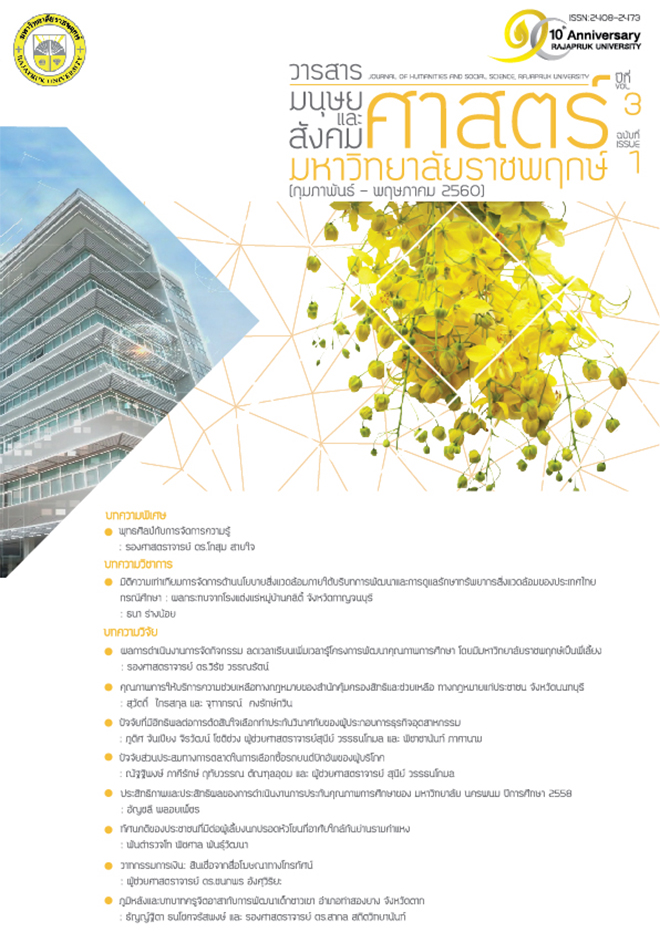The People’s Attitude towards the Red-Whiskered Bulbul Caretakers Living near Ramkhamhaeng Zone
Main Article Content
Abstract
The purposes of this research were to study; 1) generality of personal attribute of people to the nearly of people’s care red-whiskered bulbul to living at Ramkhamhaeng and 2) the influence personal attribute, environment and safety involvement on attitude of people to the nearly of people’s care red-whiskered bulbul to living at Ramkhamhaeng. The study was conducted by applying 2 research methodologies, both quantitative & qualitative. quantitative approach, questionnaire were used to collect data from 84 of red - whiskered bulbul’s caretakers. The data was analyzed, using descriptive statistics, path analysis. To the qualitative approach, in-depth interview was conducted with the person to red-whiskered bulbul caretakers and used to observed behavior. The results indicated that generality of personal attribute of people to red-whiskered bulbul caretakers to living at Ramkhamhaeng were men, age 51 - 65 years old, married, held bachelor degree, working in private actore and stay at home with 2 – 4 persons. And the finding for objective in the second study was frond that the environment was affected attitude people and had to direct influence for red-whiskered bulbul caretakers living around at Ramkhamhaeng zone.
Article Details
References
พิชศาล พันธุ์วัฒนา. (2557). นกกรงหัวจุกและการใช้ประโยชน์เพื่อชุมชนสัมพันธ์ของตำรวจในภาคใต้. วารสารหาดใหญ่วิชาการ, ปีที่ 12 ฉบับที่ 2, หน้า 105-111. ค้นเมื่อ 9 มกราคม 2560, จาก http://www.hu.ac.th/ejournal2/Dcument /y12/นกกรงหัวจุก.pdf
ราชกิจจานุเบกษา. (2546). กฎกระทรวงกาหนดชนิดของสัตว์ป่าคุ้มครองให้เป็นสัตว์ป่าชนิดหนึ่งที่เพาะพันธุ์ได้. พ.ศ.2546. ราชกิจจานุเบกษา, เล่ม 120, ตอนที่ 59ก, หน้า 11-17.
สุชาติ ประสิทธิ์รัฐสินธุ์. (2558). การสร้างมาตรวัดสาหรับการวิจัยที่ถูกต้องและได้มาตรฐานสากล.กรุงเทพฯ: สามลดา.
สุชาติ ประสิทธิ์รัฐสินธุ์. (2556). การใช้สถิติในงานวิจัยอย่างถูกต้องและได้มาตรฐานสากล. กรุงเทพฯ: สามลดา.
สุชาติ ประสิทธิ์รัฐสินธุ์. (2555). ระเบียบวิธีการวิจัยทางสังคมศาสตร์. พิมพ์ครั้งที่ 15. กรุงเทพฯ: สามลดา.
สุชาติ ประสิทธิ์รัฐสินธุ์. (2554). วิธีวิทยาการวิจัยเชิงคุณภาพยุคใหม่. กรุงเทพฯ: สามลดา.
สำนักงานสถิติแห่งชาติ กระทรวงเทคโนโลยีสารสนเทศและการสื่อสาร. (2559). สรุปผลที่สำคัญประชากรแฝงในประเทศไทยพ.ศ.2558. กรุงเทพฯ: สำนักสถิติพยากรณ์.
สำนักวิชาการ สำนักงานเลขาธิการสภาผู้แทนราษฎร. (2559). เอกสารวิชาการ Academic Focus. การปฏิรูปการปกครองท้องถิ่นรูปแบบพิเศษ: การปฏิรูปกรุงเทพมหานคร.ค้นเมื่อ 6 มกราคม 2560, จาก http://library2.parliament.go.th/ejournal/content_af/2559/feb2559-4.pdf
Biasutti, M., & Frate, S. (2017). A validity and reliability study of the attitudes toward sustainable development scale. Environmental Education Research, Vol. 23, No. 2, 214-230.
Berchtold, A. (2016). Test–retest: Agreement or reliability?. Methodological Innovations, Vol. 9, 1–7.
Creswell, J.W. (2013). Research and design: qualitative, quantitative and mixed methods approaches. 4 edition. Retrieved January 10, 2017, from https://books.google.co.th/books?hl=th&lr=&Id=EbogAQAAQBAJ&oi=fnd&pg=PR1&dq=Creswell,+J.W.++Research+and+designn:+qualitative,+quantitativee+and+ mixed+methodspdf
Demo, G., & Paschoal, T. (2016). Well-being at work scale: Exploratory and confirmatory validation in the USA. Paidéia, Vol. 26, No. 3, 35-43.
Drost, D.A. (2011). Validity and reliability in social science research. Education research and perspectives, Vol. 38, No. 1, 105-123.
Krejcie, R.V., & Morgan, D.W. (1970). Determining sample size for research activities. Journal of educational and psychological mearsurement, Vol. 30, 607-610.
Redman, T.C. (2016). Data’s Credibility Problem. Harvard business review, 14-25.


